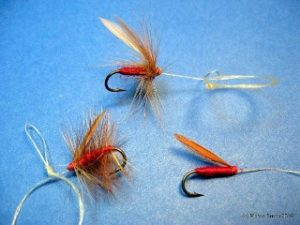First Written Record of a Fly Pattern
By Bob Randall on Sunday, April 7th, 2019 in Uncategorized, No Comments
Fly of the Month Millennium Double Millennium
From a Recipe approximately 1800 years old.
Recipe:
Hook: Bone, stone, wood, etc., straight shank, sizes 12 – 00
Thread: Horse hair, whatever color you can get, heavy. Sinew, leather, whatever you have as long as it’s strong
Body: red (crimson red) wool, can be from sheep, goat, antelope, etc
Wings: two feathers which grow under a cock’s wattles, which in colour are like wax.
Directions:
Make the hook.
Secure the horse hair to the hook shank near the hook bend.
Tie the wool to the thread.
Twist the wool into a “noodle”.
Wrap both the horse hair and wool forward to the end behind the hook eye, or knob which holds the line to the hook.
Wrap the horse hair around the forward end of the wool “noodle”.
Tie a half hitch.
Tie in two feathers with thread so that they angle backward.
Tie off horse hair thread and cut tag end.
To fish this fly:
“throw the snare, and the fish, attracted and maddened by the colour, comes straight at it, thinking from the pretty sight to gain a dainty mouthful; when, however, it opens its jaws, it is caught by the hook, and enjoys a bitter repast, a captive.”
Disclaimer: The original author made no such attempt to create a recipe. Although, the account below is essentially accurate, the recipe above is a humorous way to put it into the format that modern fly tyers use.
The truth: In approximately two hundred AD, a man, a Roman commentator named Claudius Ælianus, wrote an account, … concern(ing)s a method of fishing, with a fly, as practiced at the time in Macedonia, and is pretty much the first written record of a fly pattern, however incomplete, that we have today. … “between Borœa and Thessalonica runs a river called the Astræus, and in it there are fish with speckled skins. These fish feed upon a fly peculiar to the country, which hovers on the river. … When the fish observes a fly on the surface, it swims quietly up, afraid to stir the water above, lest it should scare away its prey; then coming up by its shadow, it opens its mouth gently and gulps down the fly, like a wolf carrying off a sheep from the fold or an eagle a goose from the farmyard; having done this it goes below the rippling water. … Now though the fishermen know this … They fasten red (crimson red) wool around a hook, and fix onto the wool two feathers which grow under a cock’s wattles, and which in colour are like wax. Their rod is six feet long, and their line is the same length.” http://seventeenthcenturyflies.blogspot.com/2011/03/macedonian-beginnings.html
